Minjing Dong
Diversifying Counterattacks: Orthogonal Exploration for Robust CLIP Inference
Nov 12, 2025Abstract:Vision-language pre-training models (VLPs) demonstrate strong multimodal understanding and zero-shot generalization, yet remain vulnerable to adversarial examples, raising concerns about their reliability. Recent work, Test-Time Counterattack (TTC), improves robustness by generating perturbations that maximize the embedding deviation of adversarial inputs using PGD, pushing them away from their adversarial representations. However, due to the fundamental difference in optimization objectives between adversarial attacks and counterattacks, generating counterattacks solely based on gradients with respect to the adversarial input confines the search to a narrow space. As a result, the counterattacks could overfit limited adversarial patterns and lack the diversity to fully neutralize a broad range of perturbations. In this work, we argue that enhancing the diversity and coverage of counterattacks is crucial to improving adversarial robustness in test-time defense. Accordingly, we propose Directional Orthogonal Counterattack (DOC), which augments counterattack optimization by incorporating orthogonal gradient directions and momentum-based updates. This design expands the exploration of the counterattack space and increases the diversity of perturbations, which facilitates the discovery of more generalizable counterattacks and ultimately improves the ability to neutralize adversarial perturbations. Meanwhile, we present a directional sensitivity score based on averaged cosine similarity to boost DOC by improving example discrimination and adaptively modulating the counterattack strength. Extensive experiments on 16 datasets demonstrate that DOC improves adversarial robustness under various attacks while maintaining competitive clean accuracy. Code is available at https://github.com/bookman233/DOC.
Revisiting Uncertainty Estimation and Calibration of Large Language Models
May 29, 2025Abstract:As large language models (LLMs) are increasingly deployed in high-stakes applications, robust uncertainty estimation is essential for ensuring the safe and trustworthy deployment of LLMs. We present the most comprehensive study to date of uncertainty estimation in LLMs, evaluating 80 models spanning open- and closed-source families, dense and Mixture-of-Experts (MoE) architectures, reasoning and non-reasoning modes, quantization variants and parameter scales from 0.6B to 671B. Focusing on three representative black-box single-pass methods, including token probability-based uncertainty (TPU), numerical verbal uncertainty (NVU), and linguistic verbal uncertainty (LVU), we systematically evaluate uncertainty calibration and selective classification using the challenging MMLU-Pro benchmark, which covers both reasoning-intensive and knowledge-based tasks. Our results show that LVU consistently outperforms TPU and NVU, offering stronger calibration and discrimination while being more interpretable. We also find that high accuracy does not imply reliable uncertainty, and that model scale, post-training, reasoning ability and quantization all influence estimation performance. Notably, LLMs exhibit better uncertainty estimates on reasoning tasks than on knowledge-heavy ones, and good calibration does not necessarily translate to effective error ranking. These findings highlight the need for multi-perspective evaluation and position LVU as a practical tool for improving the reliability of LLMs in real-world settings.
VEAttack: Downstream-agnostic Vision Encoder Attack against Large Vision Language Models
May 23, 2025Abstract:Large Vision-Language Models (LVLMs) have demonstrated remarkable capabilities in multimodal understanding and generation, yet their vulnerability to adversarial attacks raises significant robustness concerns. While existing effective attacks always focus on task-specific white-box settings, these approaches are limited in the context of LVLMs, which are designed for diverse downstream tasks and require expensive full-model gradient computations. Motivated by the pivotal role and wide adoption of the vision encoder in LVLMs, we propose a simple yet effective Vision Encoder Attack (VEAttack), which targets the vision encoder of LVLMs only. Specifically, we propose to generate adversarial examples by minimizing the cosine similarity between the clean and perturbed visual features, without accessing the following large language models, task information, and labels. It significantly reduces the computational overhead while eliminating the task and label dependence of traditional white-box attacks in LVLMs. To make this simple attack effective, we propose to perturb images by optimizing image tokens instead of the classification token. We provide both empirical and theoretical evidence that VEAttack can easily generalize to various tasks. VEAttack has achieved a performance degradation of 94.5% on image caption task and 75.7% on visual question answering task. We also reveal some key observations to provide insights into LVLM attack/defense: 1) hidden layer variations of LLM, 2) token attention differential, 3) M\"obius band in transfer attack, 4) low sensitivity to attack steps. The code is available at https://github.com/hfmei/VEAttack-LVLM
A Survey on Small Sample Imbalance Problem: Metrics, Feature Analysis, and Solutions
Apr 21, 2025Abstract:The small sample imbalance (S&I) problem is a major challenge in machine learning and data analysis. It is characterized by a small number of samples and an imbalanced class distribution, which leads to poor model performance. In addition, indistinct inter-class feature distributions further complicate classification tasks. Existing methods often rely on algorithmic heuristics without sufficiently analyzing the underlying data characteristics. We argue that a detailed analysis from the data perspective is essential before developing an appropriate solution. Therefore, this paper proposes a systematic analytical framework for the S\&I problem. We first summarize imbalance metrics and complexity analysis methods, highlighting the need for interpretable benchmarks to characterize S&I problems. Second, we review recent solutions for conventional, complexity-based, and extreme S&I problems, revealing methodological differences in handling various data distributions. Our summary finds that resampling remains a widely adopted solution. However, we conduct experiments on binary and multiclass datasets, revealing that classifier performance differences significantly exceed the improvements achieved through resampling. Finally, this paper highlights open questions and discusses future trends.
Beyond One-Hot Labels: Semantic Mixing for Model Calibration
Apr 18, 2025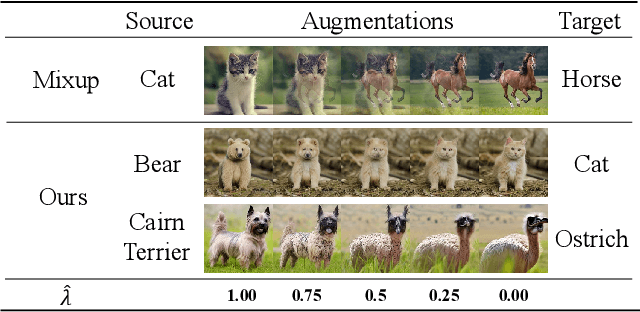



Abstract:Model calibration seeks to ensure that models produce confidence scores that accurately reflect the true likelihood of their predictions being correct. However, existing calibration approaches are fundamentally tied to datasets of one-hot labels implicitly assuming full certainty in all the annotations. Such datasets are effective for classification but provides insufficient knowledge of uncertainty for model calibration, necessitating the curation of datasets with numerically rich ground-truth confidence values. However, due to the scarcity of uncertain visual examples, such samples are not easily available as real datasets. In this paper, we introduce calibration-aware data augmentation to create synthetic datasets of diverse samples and their ground-truth uncertainty. Specifically, we present Calibration-aware Semantic Mixing (CSM), a novel framework that generates training samples with mixed class characteristics and annotates them with distinct confidence scores via diffusion models. Based on this framework, we propose calibrated reannotation to tackle the misalignment between the annotated confidence score and the mixing ratio during the diffusion reverse process. Besides, we explore the loss functions that better fit the new data representation paradigm. Experimental results demonstrate that CSM achieves superior calibration compared to the state-of-the-art calibration approaches. Code is available at github.com/E-Galois/CSM.
Survey of Adversarial Robustness in Multimodal Large Language Models
Mar 18, 2025


Abstract:Multimodal Large Language Models (MLLMs) have demonstrated exceptional performance in artificial intelligence by facilitating integrated understanding across diverse modalities, including text, images, video, audio, and speech. However, their deployment in real-world applications raises significant concerns about adversarial vulnerabilities that could compromise their safety and reliability. Unlike unimodal models, MLLMs face unique challenges due to the interdependencies among modalities, making them susceptible to modality-specific threats and cross-modal adversarial manipulations. This paper reviews the adversarial robustness of MLLMs, covering different modalities. We begin with an overview of MLLMs and a taxonomy of adversarial attacks tailored to each modality. Next, we review key datasets and evaluation metrics used to assess the robustness of MLLMs. After that, we provide an in-depth review of attacks targeting MLLMs across different modalities. Our survey also identifies critical challenges and suggests promising future research directions.
Harnessing Vision Foundation Models for High-Performance, Training-Free Open Vocabulary Segmentation
Nov 14, 2024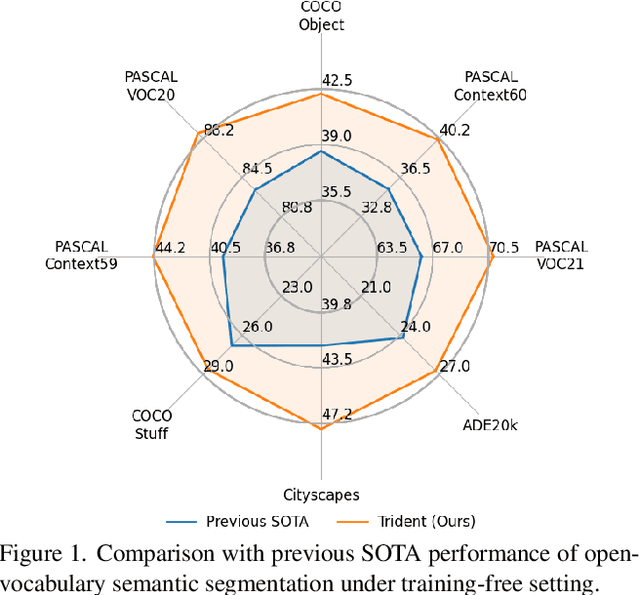
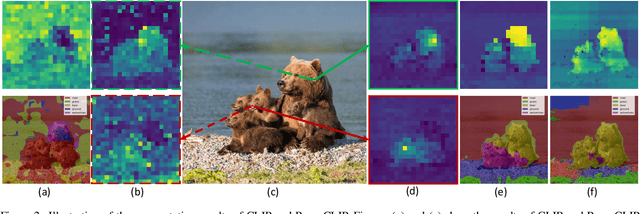
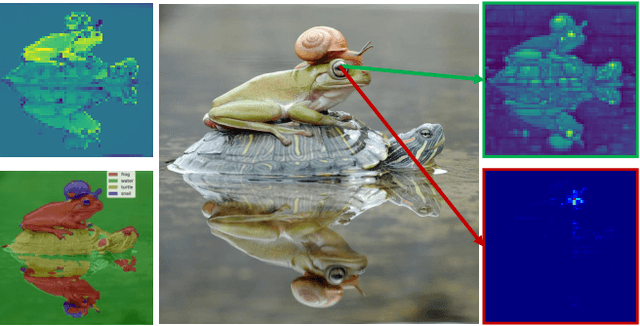
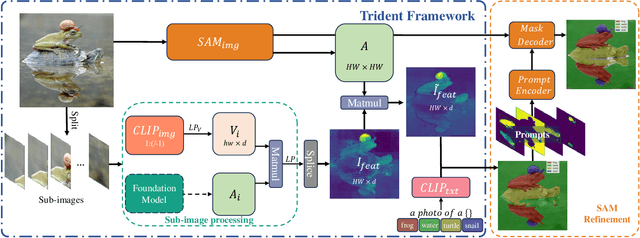
Abstract:While Contrastive Language-Image Pre-training (CLIP) has advanced open-vocabulary predictions, its performance on semantic segmentation remains suboptimal. This shortfall primarily stems from its spatial-invariant semantic features and constrained resolution. While previous adaptations addressed spatial invariance semantic by modifying the self-attention in CLIP's image encoder, the issue of limited resolution remains unexplored. Different from previous segment-then-splice methods that segment sub-images via a sliding window and splice the results, we introduce a splice-then-segment paradigm that incorporates Segment-Anything Model (SAM) to tackle the resolution issue since SAM excels at extracting fine-grained semantic correlations from high-resolution images. Specifically, we introduce Trident, a training-free framework that first splices features extracted by CLIP and DINO from sub-images, then leverages SAM's encoder to create a correlation matrix for global aggregation, enabling a broadened receptive field for effective segmentation. Besides, we propose a refinement strategy for CLIP's coarse segmentation outputs by transforming them into prompts for SAM, further enhancing the segmentation performance. Trident achieves a significant improvement in the mIoU across eight benchmarks compared with the current SOTA, increasing from 44.4 to 48.6.Code is available at https://github.com/YuHengsss/Trident.
Diffusion Attribution Score: Evaluating Training Data Influence in Diffusion Model
Oct 24, 2024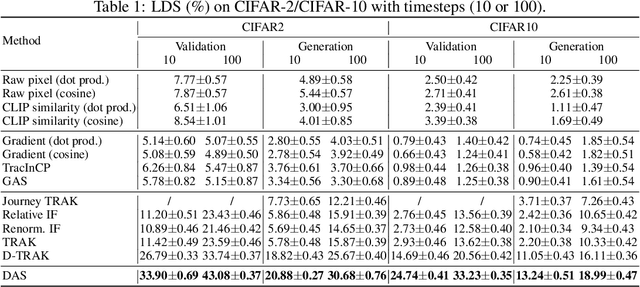


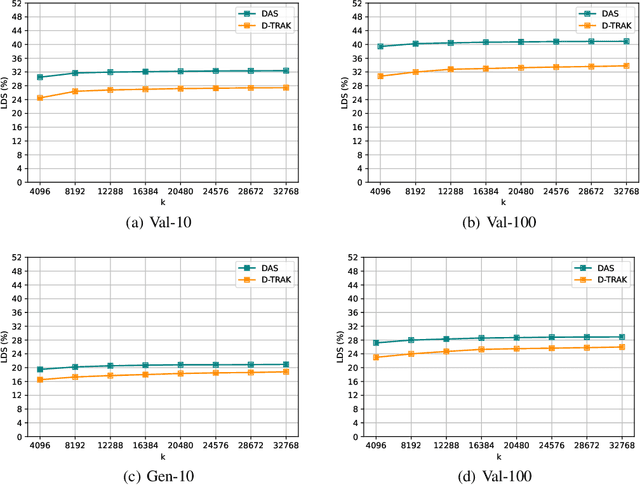
Abstract:As diffusion models become increasingly popular, the misuse of copyrighted and private images has emerged as a major concern. One promising solution to mitigate this issue is identifying the contribution of specific training samples in generative models, a process known as data attribution. Existing data attribution methods for diffusion models typically quantify the contribution of a training sample by evaluating the change in diffusion loss when the sample is included or excluded from the training process. However, we argue that the direct usage of diffusion loss cannot represent such a contribution accurately due to the calculation of diffusion loss. Specifically, these approaches measure the divergence between predicted and ground truth distributions, which leads to an indirect comparison between the predicted distributions and cannot represent the variances between model behaviors. To address these issues, we aim to measure the direct comparison between predicted distributions with an attribution score to analyse the training sample importance, which is achieved by Diffusion Attribution Score (DAS). Underpinned by rigorous theoretical analysis, we elucidate the effectiveness of DAS. Additionally, we explore strategies to accelerate DAS calculations, facilitating its application to large-scale diffusion models. Our extensive experiments across various datasets and diffusion models demonstrate that DAS significantly surpasses previous benchmarks in terms of the linear data-modelling score, establishing new state-of-the-art performance.
Consistency Calibration: Improving Uncertainty Calibration via Consistency among Perturbed Neighbors
Oct 16, 2024Abstract:Calibration is crucial in deep learning applications, especially in fields like healthcare and autonomous driving, where accurate confidence estimates are vital for decision-making. However, deep neural networks often suffer from miscalibration, with reliability diagrams and Expected Calibration Error (ECE) being the only standard perspective for evaluating calibration performance. In this paper, we introduce the concept of consistency as an alternative perspective on model calibration, inspired by uncertainty estimation literature in large language models (LLMs). We highlight its advantages over the traditional reliability-based view. Building on this concept, we propose a post-hoc calibration method called Consistency Calibration (CC), which adjusts confidence based on the model's consistency across perturbed inputs. CC is particularly effective in locally uncertainty estimation, as it requires no additional data samples or label information, instead generating input perturbations directly from the source data. Moreover, we show that performing perturbations at the logit level significantly improves computational efficiency. We validate the effectiveness of CC through extensive comparisons with various post-hoc and training-time calibration methods, demonstrating state-of-the-art performance on standard datasets such as CIFAR-10, CIFAR-100, and ImageNet, as well as on long-tailed datasets like ImageNet-LT.
Improving Fast Adversarial Training via Self-Knowledge Guidance
Sep 26, 2024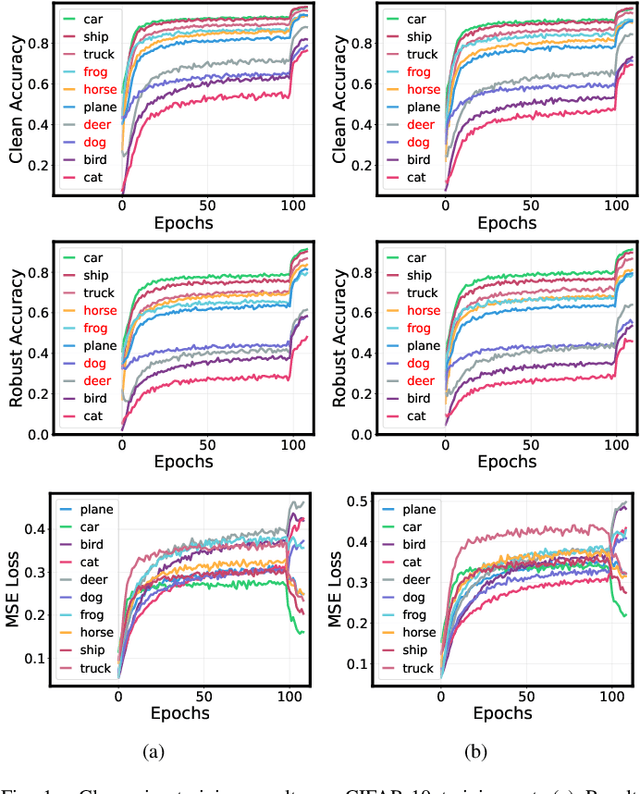
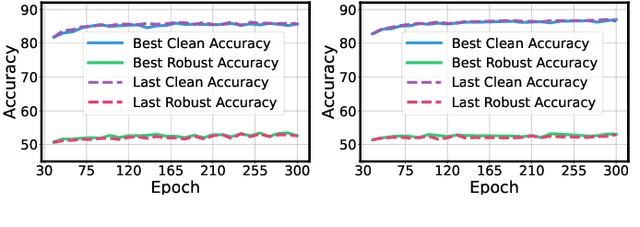
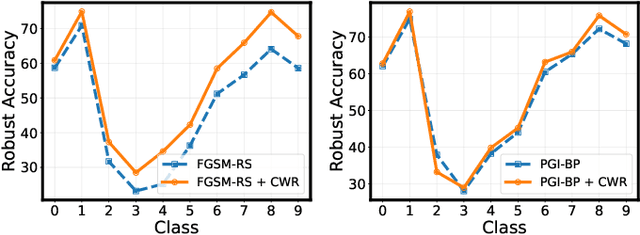
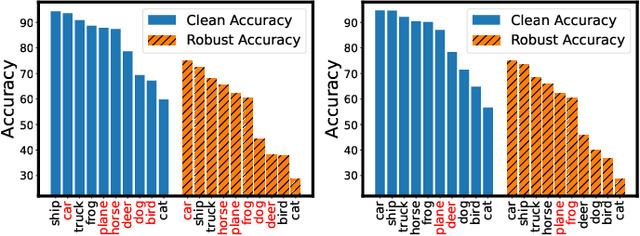
Abstract:Adversarial training has achieved remarkable advancements in defending against adversarial attacks. Among them, fast adversarial training (FAT) is gaining attention for its ability to achieve competitive robustness with fewer computing resources. Existing FAT methods typically employ a uniform strategy that optimizes all training data equally without considering the influence of different examples, which leads to an imbalanced optimization. However, this imbalance remains unexplored in the field of FAT. In this paper, we conduct a comprehensive study of the imbalance issue in FAT and observe an obvious class disparity regarding their performances. This disparity could be embodied from a perspective of alignment between clean and robust accuracy. Based on the analysis, we mainly attribute the observed misalignment and disparity to the imbalanced optimization in FAT, which motivates us to optimize different training data adaptively to enhance robustness. Specifically, we take disparity and misalignment into consideration. First, we introduce self-knowledge guided regularization, which assigns differentiated regularization weights to each class based on its training state, alleviating class disparity. Additionally, we propose self-knowledge guided label relaxation, which adjusts label relaxation according to the training accuracy, alleviating the misalignment and improving robustness. By combining these methods, we formulate the Self-Knowledge Guided FAT (SKG-FAT), leveraging naturally generated knowledge during training to enhance the adversarial robustness without compromising training efficiency. Extensive experiments on four standard datasets demonstrate that the SKG-FAT improves the robustness and preserves competitive clean accuracy, outperforming the state-of-the-art methods.
 Add to Chrome
Add to Chrome Add to Firefox
Add to Firefox Add to Edge
Add to Edge